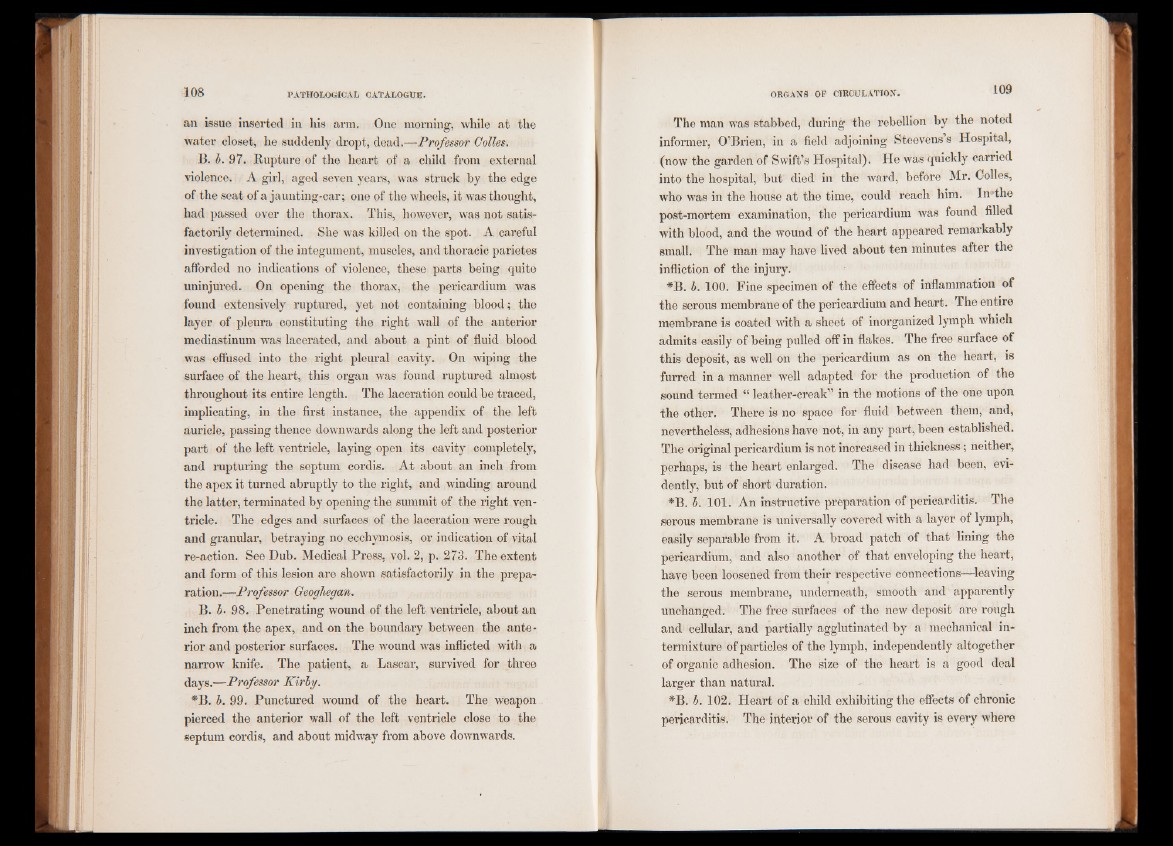
an issue inserted in his arm. One morning, while at the
water closet, he suddenly dropt, dead.—Professor Colles.
B. b. 97. Rupture of the heart of a child from external
violence. A girl, aged seven years, was struck by the edge
of the seat of a jaunting-car; one of the wheels, it was thought,
had passed over the thorax. This, however, was not satisfactorily
determined. She was killed on the spot. A careful
investigation of the integument, muscles, and thoracic parietes
afforded no indications of violence, these parts being quite
uninjured. On opening the thorax, the pericardium was
found extensively ruptured, yet not containing blood; the
layer of pleura constituting the right wall of the anterior
mediastinum was lacerated, and about a pint of fluid blood
was effused into the right pleural cavity. On wiping the
surface of the heart, this organ was found ruptured almost
throughout its entire length. The laceration could be traced,
implicating, in the first instance, the appendix of the left
auricle, passing thence downwards along the left and posterior
part of the left ventricle, laying open its cavity completely,
and rupturing the septum cordis. At about an inch from
the apex it turned abruptly to the right, and winding around
the latter, terminated by opening the summit of the right ventricle.
The edges and surfaces of the laceration were rough
and granular, betraying no ecchymosis, or indication of vital
re-action. See Dub. Medical Press, vol. 2, p. 273. The extent
and form of this lesion are shown satisfactorily in the preparation.—
Professor Geoghegan.
B. b• 98. Penetrating wound of the left ventricle, about an
inch from the apex, and on the boundary between the anterior
and posterior surfaces. The wound was inflicted with a
narrow knife. The patient, a Lascar, survived for three
days.—Professor Kirby.
*B. b. 99. Punctured wound of the heart. The weapon
pierced the anterior wall of the left ventricle close to the
septum cordis, and about midway from above downwards.
The man was stabbed, during the rebellion by the noted
informer, O’Brien, in a field adjoining Steevens’s Hospital,
(now the garden of Swift’s Hospital). He was quickly carried
into the hospital, but died in the ward, before Mr. Oolles,
who was in the house at the time, could reach him. InHhe
post-mortem examination, the pericardium was found filled
with blood, and the wound of the heart appeared remarkably
small. The man may have lived about ten minutes after the
infliction of the injury.
*B. b. 100. Fine specimen of the effects of inflammation of
the serous membrane of the pericardium and heart. The entire
membrane is coated with a sheet of inorganized lymph which
admits easily of being pulled off in flakes. The free surface of
this deposit, as well on the pericardium as on the heart, is
furred in a manner well adapted for the production of the
sound termed “ leather-creak” in the motions of the one upon
the other. There is no space for fluid between them, and,
nevertheless, adhesions have not, in any part, been established.
The original pericardium is not increased in thickness; neither,
perhaps, is the heart enlarged. The disease had been, evidently,
but of short duration.
*B. b. 101. An instructive preparation of pericarditis. The
serous membrane is universally covered with a layer of lymph,
easily separable from it. A broad patch of that lining the
pericardium, and also another of that enveloping the heart,
have been loosened from their respective connections—leaving
the serous membrane, underneath, smooth and apparently
unchanged. The free surfaces of the new deposit are rough
and cellular, and partially agglutinated by a mechanical intermixture
of particles of the lymph, independently altogether
of organic adhesion. The size of the heart is a good deal
larger than natural.
*B. b. 102. Heart of a child exhibiting the effects of chronic
pericarditis. The interior of the serous cavity is every where